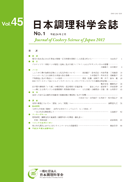Volume 45, Issue 2
Displaying 1-14 of 14 articles from this issue
- |<
- <
- 1
- >
- >|
Memorial Paper for Society Award of the Japan Society of Cookery Science in 2011
-
2012 Volume 45 Issue 2 Pages 71-80
Published: 2012
Released on J-STAGE: March 14, 2014
Download PDF (1256K)
Memorial Paper for Encouragement Award of the Japan Society of Cookery Science in 2011
-
2012 Volume 45 Issue 2 Pages 81-87
Published: 2012
Released on J-STAGE: March 14, 2014
Download PDF (1545K) -
2012 Volume 45 Issue 2 Pages 88-95
Published: 2012
Released on J-STAGE: March 14, 2014
Download PDF (1044K)
Original paper
-
2012 Volume 45 Issue 2 Pages 96-103
Published: 2012
Released on J-STAGE: March 14, 2014
Download PDF (1373K) -
2012 Volume 45 Issue 2 Pages 104-114
Published: 2012
Released on J-STAGE: March 14, 2014
Download PDF (1866K) -
2012 Volume 45 Issue 2 Pages 115-122
Published: 2012
Released on J-STAGE: March 14, 2014
Download PDF (1043K) -
2012 Volume 45 Issue 2 Pages 123-132
Published: 2012
Released on J-STAGE: March 14, 2014
Download PDF (737K) -
2012 Volume 45 Issue 2 Pages 133-140
Published: 2012
Released on J-STAGE: March 14, 2014
Download PDF (1109K)
Note
-
2012 Volume 45 Issue 2 Pages 141-147
Published: 2012
Released on J-STAGE: March 14, 2014
Download PDF (1069K)
Technical report
-
2012 Volume 45 Issue 2 Pages 148-152
Published: 2012
Released on J-STAGE: March 14, 2014
Download PDF (767K)
Course text
-
2012 Volume 45 Issue 2 Pages 153-159
Published: 2012
Released on J-STAGE: March 14, 2014
Download PDF (869K)
Educational materials research
-
2012 Volume 45 Issue 2 Pages 160-163
Published: 2012
Released on J-STAGE: March 14, 2014
Download PDF (1157K)
Cooking room
-
2012 Volume 45 Issue 2 Pages 164-167
Published: 2012
Released on J-STAGE: March 14, 2014
Download PDF (1092K)
Topics & opinion
-
2012 Volume 45 Issue 2 Pages 168-169
Published: 2012
Released on J-STAGE: March 14, 2014
Download PDF (991K)
- |<
- <
- 1
- >
- >|
